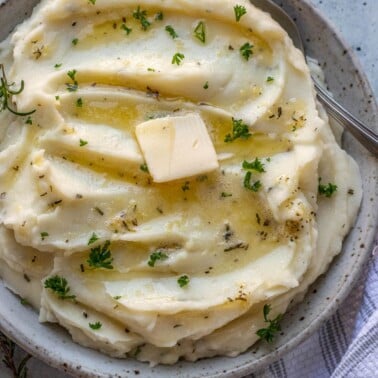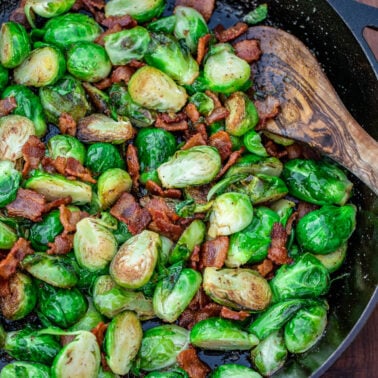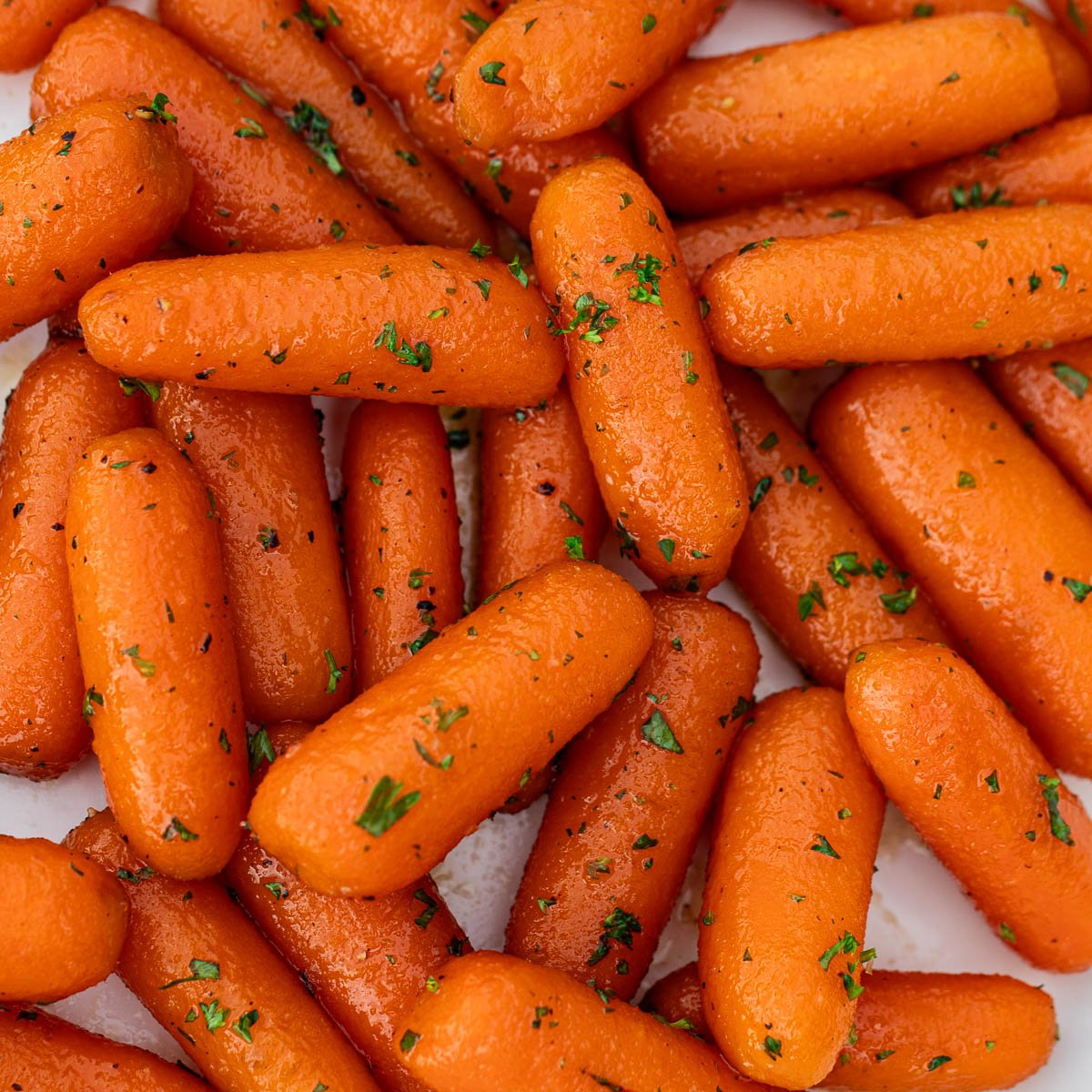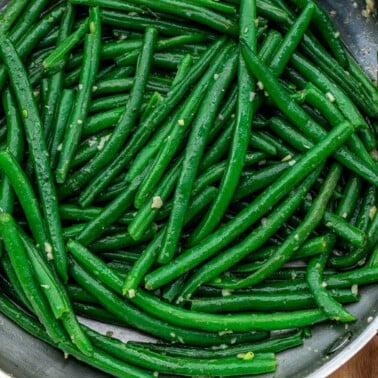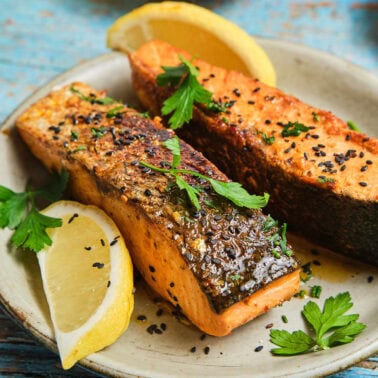Bone In Ribeye Steak
Published Jul 03, 2025
Updated Sep 30, 2025
This post may contain affiliate links. Please read our disclosure policy.
A well-cooked ribeye steak is juicy and melt-in-the-mouth good. Make that a Bone In Ribeye Steak, and you have a phenomenal, unforgettable steak!
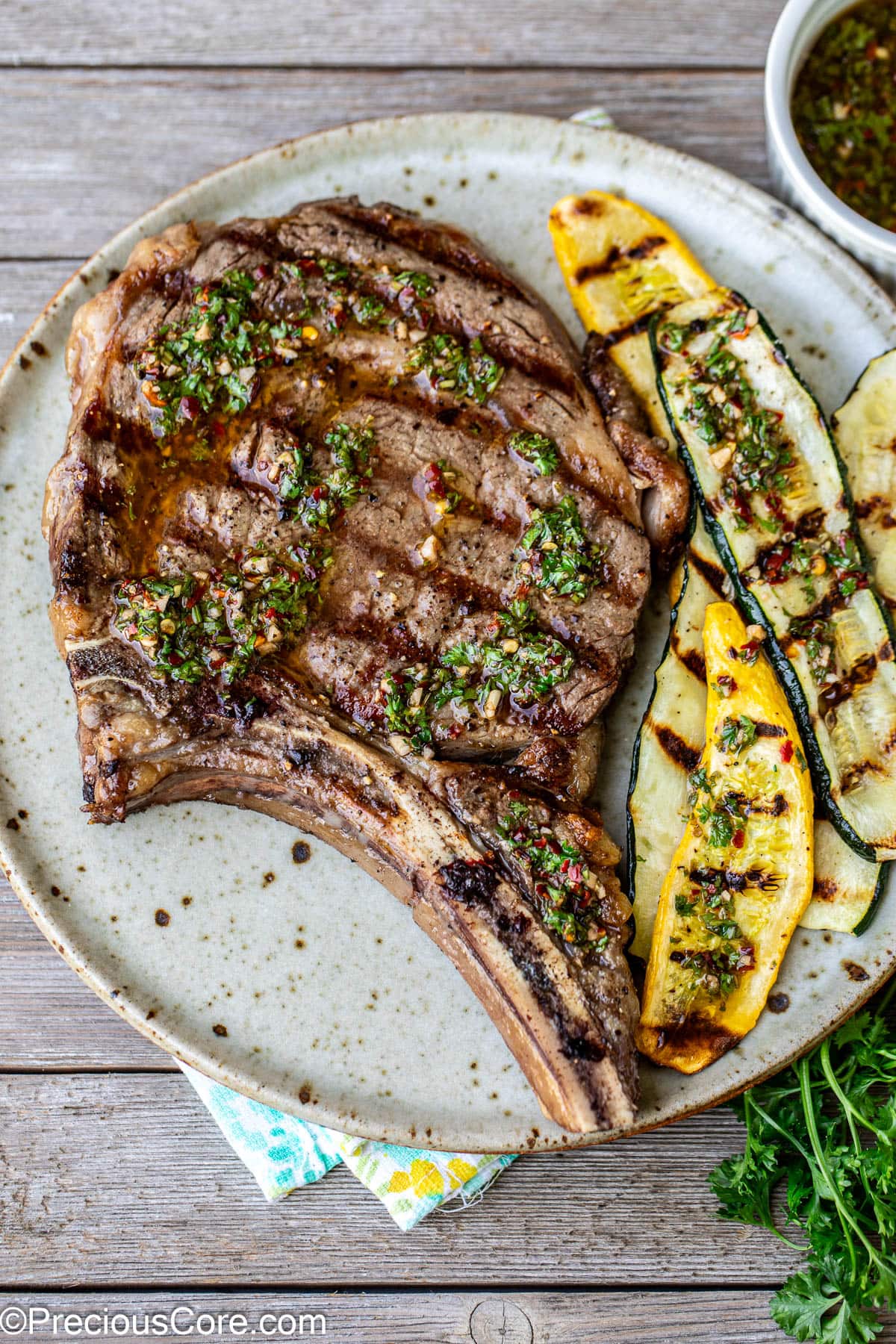
With the bone in, the steak is even juicier, and the bone imparts more flavor. I love cooking bone-in ribeye on the grill, but you can also pan-sear or bake it. See the post for different cooking methods.
Today, I’ve got the ultimate guide to cooking a bone-in ribeye steak so you can make the steak of your dreams! Forget going to a fancy restaurant just to have steak.
You can make your own thick-cut, flavorful steaks in the comfort of your home. And they can be high-quality. It is much easier than you might assume.
If you’re totally a steak person like me, don’t forget to check out some of my other steak recipes. For example, I have Steak and Pasta for a yummy weeknight dinner or a Ribeye Steak Sandwich that’s perfect for lunch! There’s also Steak Fried Rice you can try if you want a one-pot (or wok, in this case) meal!
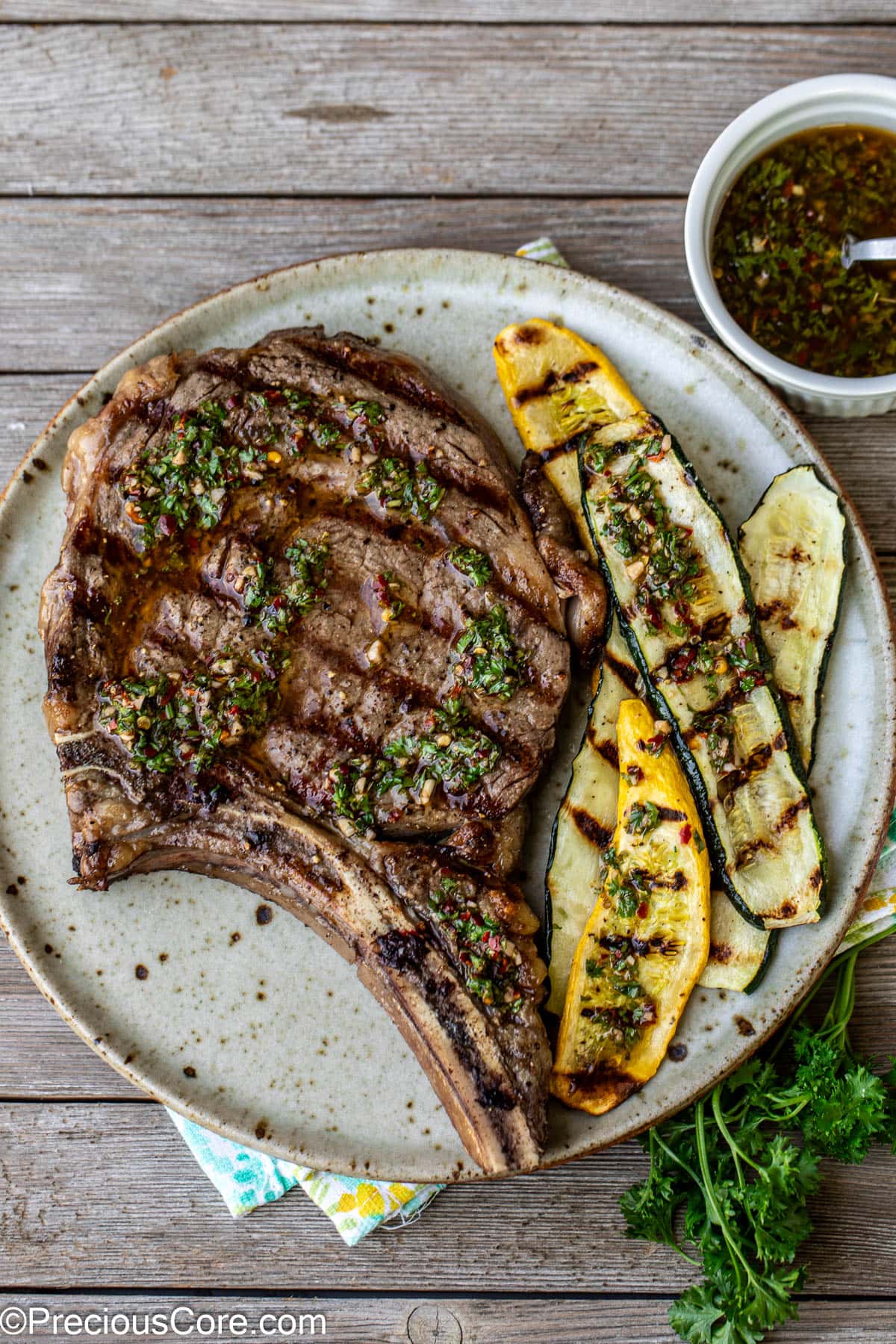
Bone In Ribeye Steak Recipe
Ribeyes are such great steaks. They have so much flavor (more than filet mignon!), and they’re such a juicy cut compared to some other types of steak. Other names you might know them by are tomahawk steak or cowboy steak.
A ribeye steak cut comes from the rib section (just as prime rib does). More specifically, it is one of the cuts received from under the front section of the backbone. Because of where it comes from, it boasts excellent taste and texture, resulting in high quality.
You can make these bone-in steaks for special occasions or when you’re craving a nice, hearty dinner. With this guide, I’ll explain the methods of both indoor cooking and outdoor grilling bone-in ribeyes.
For the best steak possible, I like purchasing my steaks from my local butcher shop, but you can also get them from the grocery store if that’s not an option for you.
Ingredients Needed
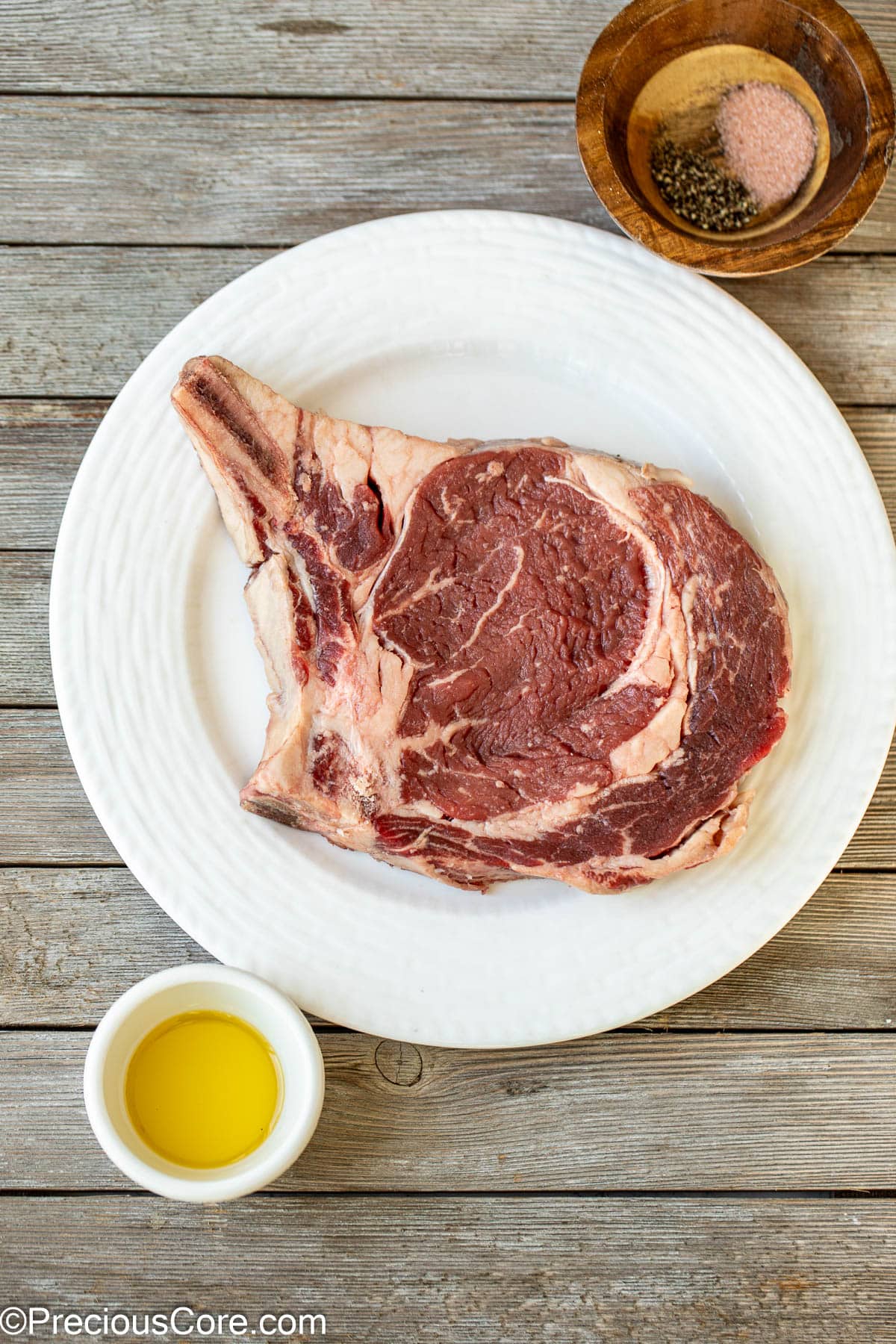
- Bone-In Ribeye Steaks: For a ribeye recipe serving 4 people, you’ll need 1 pound of bone in ribeye steak, about 1 inch thick.
- Olive Oil: Olive oil helps the seasonings adhere to the meat and also prevents the steak from sticking to the skillet or grill.
- Salt: Any type of salt is fine. Just remember that kosher salt is not as salty as table salt, so you’ll likely need more than what the recipe card suggests. I used pink Himalayan salt because that is what I had on hand.
- Ground Black Pepper: This simple, classic seasoning pairs well with salt and helps to highlight the meat’s natural, delicious flavors.
Recipe Variations
Here are some variations for this rib eye steak recipe:
- Butter vs. Oil: If you grill the meat, all you need is olive oil. However, if you oven-bake or cook it on the stovetop, you can also use melted butter for basting, providing a rich and robust flavor.
- Seasonings: Bone-in ribeyes really don’t need many seasonings to have great flavor! Although you don’t necessarily need other seasonings, you can also use some smoked paprika, onion powder, tarragon, or minced onions. However, these seasonings can burn at high temperatures if put on top of the steak, so it is best to add them at the end of cooking.
- Herbs: Use fresh herbs, such as rosemary or thyme. If you cook the meat in a hot skillet or oven, add the herbs to the pan partway through cooking. The herb flavor can infuse into the butter or oil, so you can use whole sprigs without chopping them.
- Garlic: If cooking the rib eye steaks in a hot pan like a cast-iron skillet on the stovetop, you can include minced garlic cloves and baste the steak with butter and the minced garlic as it cooks to impart a deeper flavor. Add the garlic towards the end of cooking since it will cook quickly.
How To Cook A Bone In Ribeye Steak
There are many different ways to cook bone in ribeye steak. Below, you can find information on your preferred method!
No matter how you cook it, make sure to let the meat rest on a cutting board at room temperature beforehand and pat it dry with paper towels. Drizzle the olive oil on both sides of the steak and season both sides with salt and pepper. And remember, after cooking the meat, cover it and allow it to rest for a few minutes before serving.
1. Pan Seared Method
- Preheat a large skillet, such as a cast iron skillet, over medium heat for at least 5 minutes or until thoroughly hot. Increase the temperature to medium-high.
- Prep the steaks with olive oil and seasonings. Also, put some oil in the pan and tilt it to coat the skillet. Wait until the oil shimmers.
- Cook the steaks for about 3-5 minutes on each side, depending on your preference of doneness. You can add butter and herbs to the pan, let the butter melt, and then baste the meat after flipping it from the first side.
2. Oven Method
- For this method, I suggest using 250-275 degrees Fahrenheit. Preheat the oven and prep the steak as usual.
- To start, place bone in ribeye steaks on a wire rack over a sheet pan and bake for 35-40 minutes, checking on their temperature. They don’t need to be fully ready, just about 110-120F internally.
- When it’s been nearly 40 minutes, you can preheat a skillet on high heat on the stovetop. Add oil and wait until it shimmers, tilting to coat the pan.
- Once they are almost to your desired temperature, transfer the ribeyes to the hot pan and quickly sear them to give them a crust. It will take less than 1 minute on each side, maybe even as little as 30 seconds, so be careful!
3. Gas Grill Method
- Preheat the grill to high while prepping the steaks.
- Place the steak on the grill and grill for 4 to 5 minutes per side or until desired doneness, following the steak cooking guide in the post.
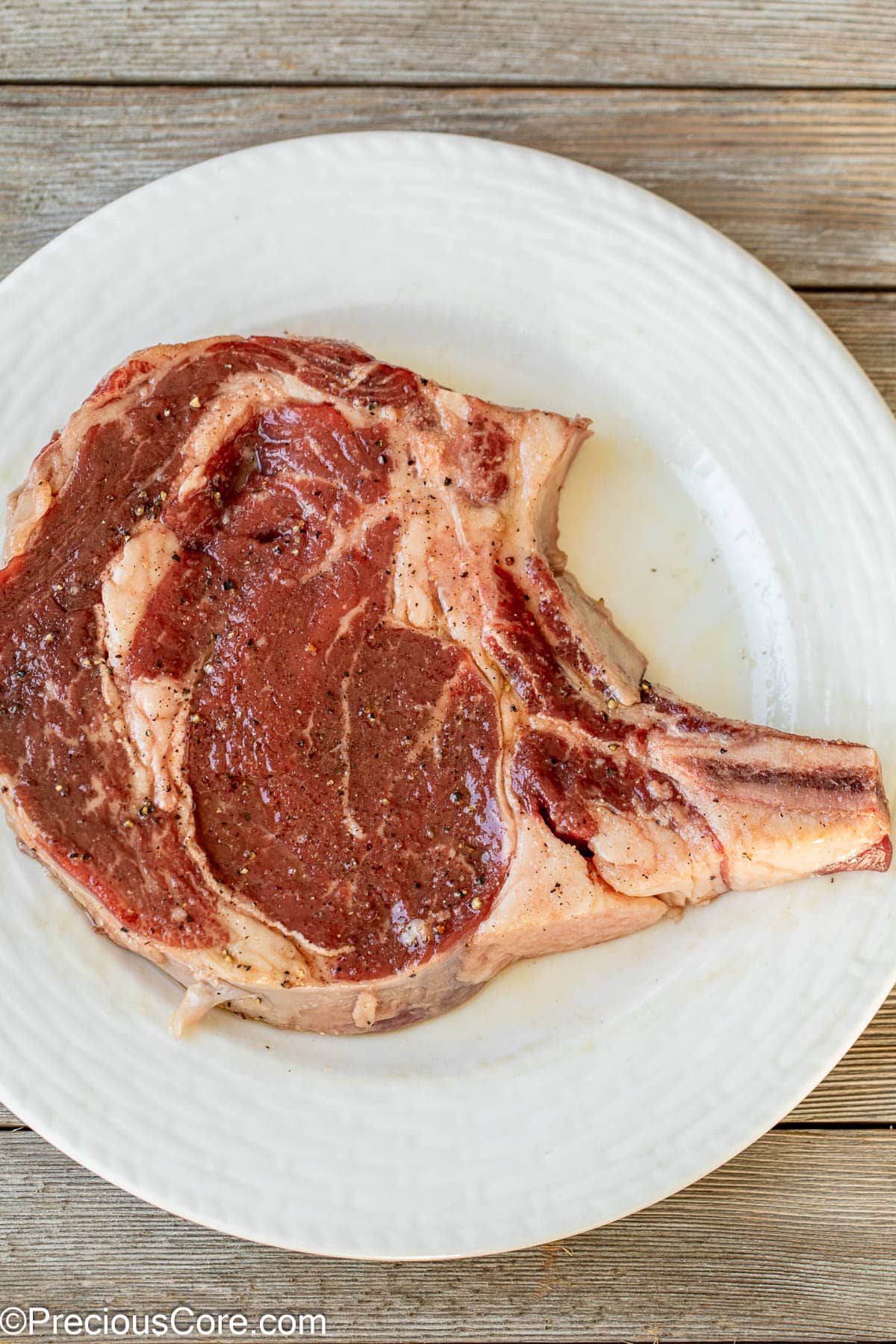
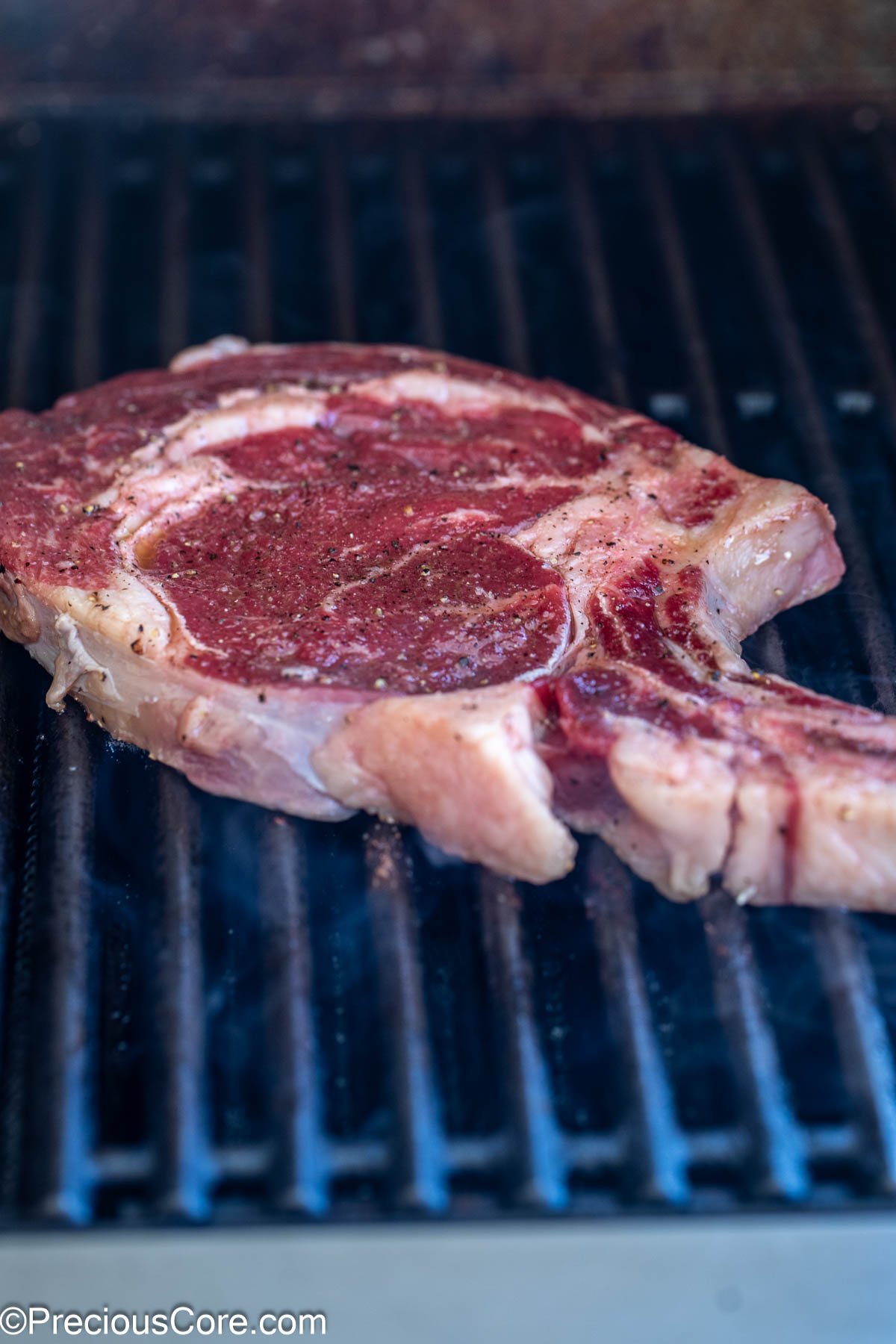
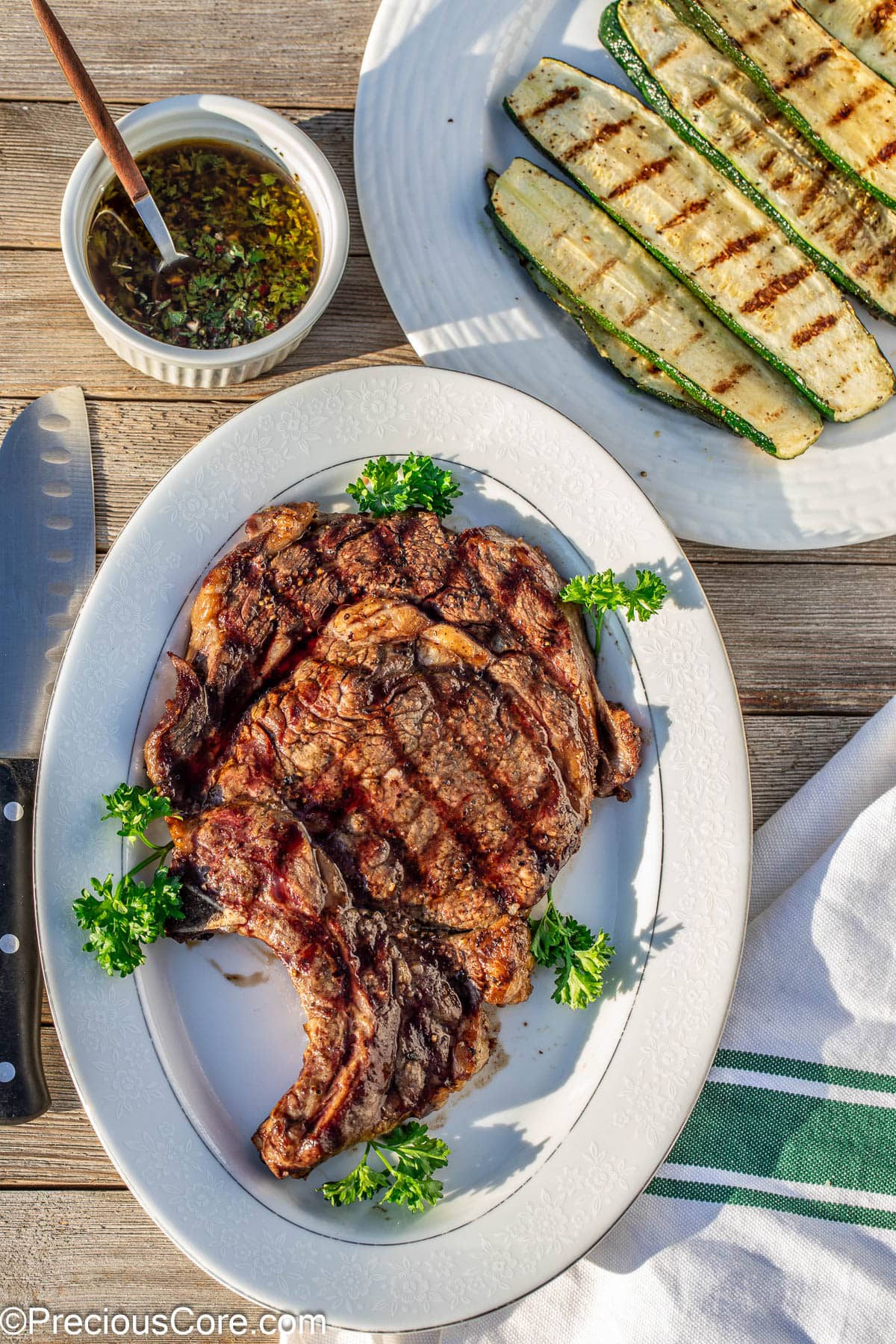
4. Charcoal Grill Method
- Prepare the grill for two-zone cooking so you can sear on direct heat and finish cooking with indirect heat. Prep the steaks as usual.
- Cook ribeyes over the hottest coals to sear them with direct heat and get a nice crust (1-2 minutes on each side).
- Then, move the meat to the warm side of the grill and continue to grill for 4-7 minutes on each side, depending on your desired doneness. You can flip them once while the meat cooks indirectly, but you don’t need to flip them continuously.
Always dry steak with paper towels before seasoning and cooking.
Steak Temperature Guide
- Rare: 120-125°F: At this point, the center is still red, and the steak is very tender and juicy.
- Medium Rare: 130-135°F: At this temperature range, about half of the center will be red.
- Medium: 140-145°F: The center will be pink and just barely warm to the touch with medium steaks.
- Medium Well: 150-155°F: The meat is cooked throughout, but there are still some pink hints.
- Well Done: 160-165°F: The meat is entirely browned, inside and outside, and is thoroughly warm.
When checking the steak’s temperature, use a kitchen thermometer to reach the center with the thermometer tip, avoiding touching the bone.
Finger and Palm Method
If you don’t have a thermometer, you can also use the finger and palm method to test the bone in ribeye steak doneness. Simply press your finger against the meat and compare it to the feel of your palm (in the area below your thumb) in different scenarios. The softness or toughness of your palm changes slightly as you move it, so you can practice by touching your thumb to your different fingers and observing the changes in the palm.
- Raw Steak: How your palm feels with your open hand, relaxed.
- Medium-Rare Steaks: How your palm feels with the middle finger and thumb touching.
- Medium Steaks: How your palm feels when the ring finger and thumb touch.
- Medium-Well Steaks: How your palm feels when the pinky and thumb touch.
This method can take some practice for certain people, so if you have a thermometer, you can always use both methods just to be sure.
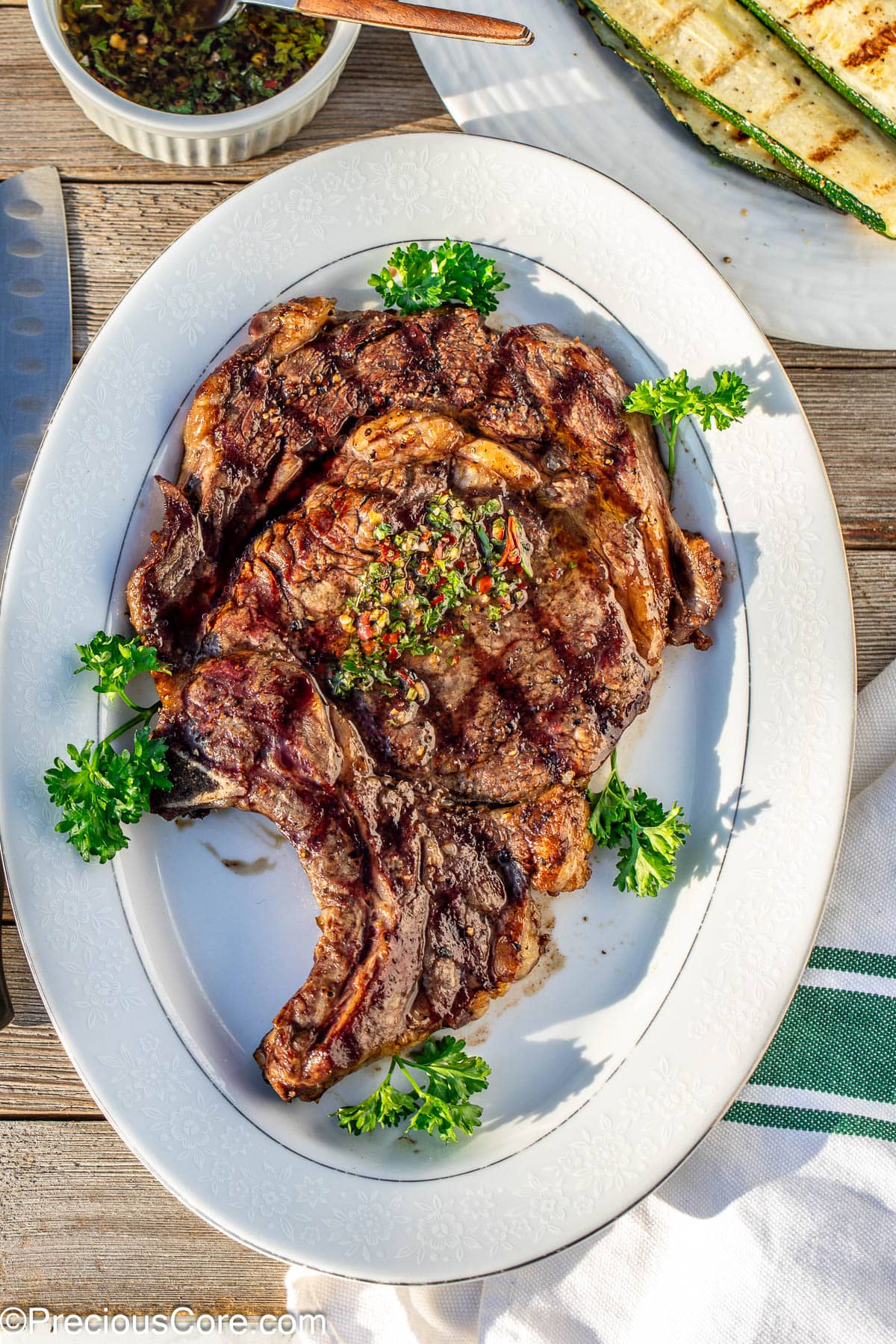
Tips For Perfect Bone In Ribeye Steak
- Remember that the steak will continue to cook after you remove it from the heat, so the best way to make perfect steak is to stop cooking it slightly before the preferred doneness. This is why using a meat thermometer is helpful so you can know the internal temperature which indicates exactly how far along it is in the process.
- Don’t cut the center of the steak to check for doneness; doing so will cause it to dry out, causing you to lose much-needed, wonderful juices.
- Store any extra bone-in ribeye steak in an airtight container in the refrigerator. I do not suggest reheating the steak in the microwave, as it will give it an unpleasant texture. Instead, consider reheating it gently in a 250F oven and then moving it to the stovetop for a quick sear with high heat to finish it off and give it the best texture possible. This is essentially a reverse sear method.
- When cooking steaks, allow them to cook on each side without flipping constantly, giving them time to form a crust on the outside of the steak.
Bone In Ribeye Steak FAQs
Although I love the grill, this honestly comes down to personal preference and all of the methods I mentioned here are great methods for cooking it; there isn’t one specific cooking process that is best!
Yes, by keeping the bone in, you get extra flavor that you otherwise wouldn’t have. The rib bones have fat content attached to them, so this also means the steak is extra tender. The bone also insulates the meat as it cooks.
Since ribeye steak already has a naturally juicy texture and is flavorful, you don’t need to worry about a marinating process when cooking it! Just be sure not to overcook it, and you’ll be fine.
Serving
I love throwing some zucchini on the grill to go with the ribeye, but you can serve it with the following side dishes too:
More Steak Recipes
- Pan Seared Flank Steak
- Steak and Pasta
- Pan Seared Ribeye Steaks
- Steak and Scrambled Eggs
- Steak Fried Rice
If you make this recipe please leave a star rating below. Your rating helps others find the recipe plus I love hearing from you! Thank you!

Bone In Ribeye Steak
Equipment
- Gas grill
Ingredients
- 1 pound bone in ribeye steak 1 inch thick
- 1 Tablespoon olive oil
- ½ teaspoon salt
- ¼ teaspoon ground black pepper
Instructions
- Bring steak to room temperature for about an hour before cooking. Pat dry the steak thoroughly with paper towels to remove excess moisture.
- Preheat the grill on high heat.
- Drizzle the olive oil on both sides of the steak and season both sides with salt and pepper.
- Place steak on the grill and grill for 4 to 5 minutes per side or until desired doneness, following the steak cooking guide in the post.
- Transfer the meat to a plate and cover with foil. Let it rest for 5 minutes before serving.
